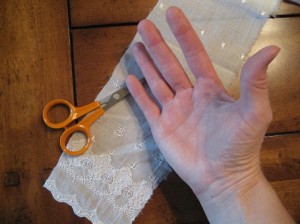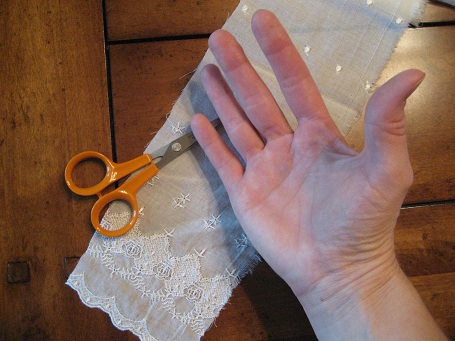
Summer always seems to be full of sewing projects. I don’t know about you, but with balls, soirees, teas and costume gatherings my sewing table is piled with stuff to make.
With all this busy sewing comes weather I’d rather see pass on quickly. Heat, high humidity, rain storms (or super dry weather if you’re in the desert) and a blazing sun make for challenging conditions to keep up with all the projects due.
So as you’re trying to stay cool under fans, air conditioning units and ice tea, here are a few tips for keeping your hands clean while plowing the thread fields.
1. Wash your hands often. This goes for both machine and hand sewing. I’m constantly washing my hands as I sew because textiles can have lots of grime embedded in the fibers that can rub off onto the hands (and other surfaces too) – even if they’re pre-washed.
Also, in the normal course of working with scissors, awls, pins and the iron, our hands naturally produce oils. This can give me sweaty hands. So I wash regularly. And if you’re pattern drafting, washing your hands is especially important. You don’t want pencil lead to get on your fabrics.
2. Clean your hand needles with an emery strawberry often. The rough sand will help with the hand oil build-up. But they don’t last forever, so…
3. Throw out your hand needles after using them with several projects. After prolonged use, the friction on the steel needles (from both skin and textiles) will cause oils and dirt to stick to the needle making it hard to push through fabric.
I confess I’ll stick my used needles in a corkboard and reuse them over and over. Probably TOO much past the point of throwing away and getting new ones. I’m always buying new hand needles but don’t throw away the old ones!
4. Don’t apply a greasy lotion to your hands right before sewing. Put it on at least ½ hour before so it can get absorbed into the skin. If you have a dry hand skin problem, try applying lotion before bed, when you get up in the morning, and at other times – just not before sewing.
5. Turn on a small fan near your workstation so you can cool off your hands whenever they start to feel warm. This will keep you cooler too. And when your body temp is cooler, your hands will not sweat. I like to hold my hands in front of a fan every so often just to dry out the perspiration that’s on them, then wash them when that stops working.
6. To go along with #5, if you’re working with heavy fabrics or project, keep it off your lap as much as possible to keep your body cool. Throw it on a side chair or sofa arm or even your cutting table as you hand sew.
7. And lastly, keep hydrated with water, and in moderation, tea. In any season this will help your hands stay soft so you use less lotion, which in turn helps excess oil from forming.
Sweating is the body’s natural process of cooling down. Keep yourself cool and hydrated and you’ll avoid Sweaty Palm Syndrome.
What other methods do you use to keep your hands cool and un-sweaty?


Hi Jennifer!
Thank you for your answer and advice. I will put the bones back in and then handwash the stays.
My deepest apologies to Mrs Depew Vintage, I misread your post. Sorry.
Very best regards
Dear Jennifer, I hope you and your family are doing fine despite everything happening around…. If you have time, coud you please tell me what is safer for my Regency corset. I made adjustments on my 5-year old Regency stays (the bright side of the quarantine: I have time for improving the underthings) but I didn’t “avoid sweaty palms” and it definitely needs a good wash. Now should I put the bones back into my corset before washing it ? or should I wait when it is completely dry?
By the way I’m really excited by your New Perfection Tailoring System from 1901 project, so yes, your work” will have all been completely worth it”! Unfortunately I can’t use “measurements between 20-40″ bust”. 20? really? I will make the skirts….
Thank you. Take care.
Hi Christine,
First, it’s not mine… the 1901 tailoring system, that I shared on Facebook. That has been accomplished by Mrs Depew Vintage. She’s done an amazing service for us!
As for washing the corset, you should be just fine hand washing it and line drying with bones in it. If the bones are already removed, it will be easier to put them in when the fabric is dry. But I understand your concern with the fabric “shrinking”. If concerned, put the bones back in and wash. Good luck!
My mother told me that she would use a 5-day antiperspirant pad, rubbing it on her palms prior to a date, to avoid sweaty hands. I wonder if one of the “non-marking” antiperspirants available today would work?
My grandmother told me most of these rules when teaching me to tat. And yes, several of my dresses and collars sport lace I tatted. As a former manicurest one of my most recommended hand care regimes is to wash my hands before going to bed, warming some lotion and slathering it on my hands and donning white cotton gloves. In the morning hands are soft and clean. .
como puedo comprar algun patron
un saludo gracias
I have two: Take breaks–this helps cool off not only your hands, but your head as well. And, try to keep fabric on a table and off your lap as much as possible! Even if you’ve got it heaped on either side of you while you’re hemming that nine yards of skirt hem, use one of those little folding tables over your lap to glide the fabric over. It’s AMAZING how much difference this makes.
Oh, and if you’re truly desperate, a trick I’ve used when working with fondant and chocolate (both of which melt if you have hot hands) is to dip your hands briefly in a bowl of cold water. I usually combine this with using vinyl disposable gloves, which are very easy to towel obsessively dry with a paper towel (fondant melts and chocolate seizes in the presence of water). I haven’t tried using gloves when sewing, but I don’t think it can be any harder than sculpting fondant/chocolate flowers with fiddly little tools.
Oops, well, guess I missed reading point 6! ^_^;
I use talcum powder. A period method I’ve read about in vintage sources is to rub hands with blocks of magnesia, (which is talc), “available at any druggist”. I’m not sure if the blocks pf magnesia referred to are actual chunks of the mineral, or some kind of compresssed cakes of talc, but the powder does work!
That is a great suggestion. (And I’m with you – I’ll stick to the powder form!)